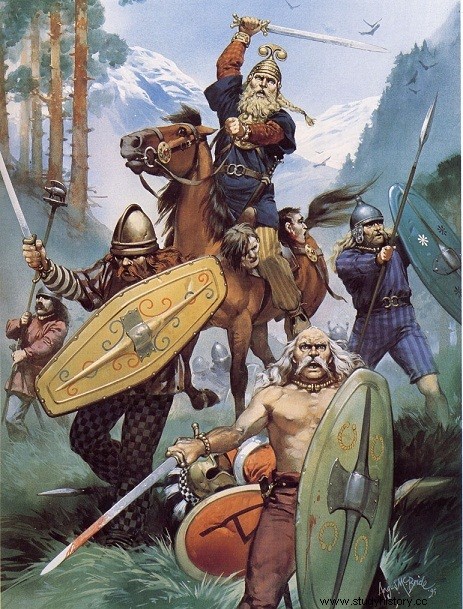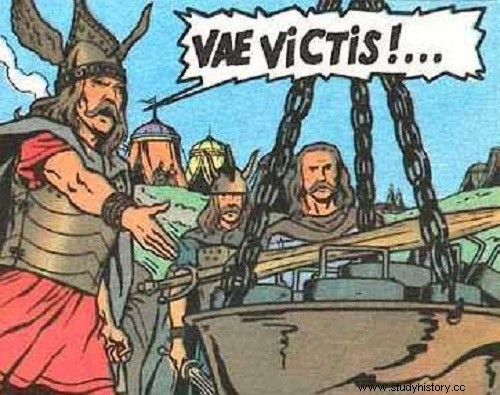Back in the fourth century B.C. Rome It was an incipient Republic, compressed in the center of the Italian peninsula, whose only alternative for growth was to absorb all those peoples that surrounded it in its expansion. Etruscans, Samnites, Aequi and Volcans ended during that time under the Roman yoke. It was the year 391 B.C. Rome maintained a tense, and at times belligerent, situation with its northern neighbor, Etruria .
A few years ago a Gallic tribe, the Senones, had crossed the Alps. to be more specific, commanded by a peculiar individual, King Breno , the only chief of Celtic tribes who managed to wear a crown in Gaul before Vercingetorix. They settled in the area that was later renamed Galia Cisalpina (the current Po valley) removing from there the Umbrians who inhabited those lands. Brennos's ambition was not content with this new territory. That same year, seeing the weakness of the neighborhood and the possibility of getting a quick and large booty, the Senones attacked Etruria, besieging the city of Clusium (Chiusi, in Tuscany) The Etruscans, weighing the lesser evil between the two fearsome forces that imprisoned them, asked Rome for help, help that arrived in time. The trigger of the hostilities between Gauls and Romans was Quintus Fabius , one of those sent by Rome, who killed one of the Gallic leaders during the negotiations. This vile Roman meddling, and the total lack of retaliation for such insult by the Senate, so angered King Brennus that, feeling insulted, he broke camp and stood before Rome.

The City did not have any energetic man at the head of its legions at that time. The only one capable of stopping Breno, Marco Furio Camilo , was absent, voluntarily exiled in Ardea after being accused by the tribune of the plebs Lucius Apuleius of embezzling funds from the immense booty obtained after the surrender of the Etruscan city of Veyes . According to tradition, on July 18, 390 B.C. the Gauls massacred the Roman troops commanded by Quintus Sulpice at the battle of the Alia river , very close to Rome. The flanks, occupied by the most inexperienced and poorly equipped troops, yielded to the pressure and the Gallic mass enveloped the bulk of the heavy infantry. The survivors of that disaster arrived in Rome in a panic, climbing towards the Palatine without thinking of closing the gates. Thanks to such negligence, the Gauls entered the streets of Rome with blood and fire. Almost all the documentation prior to this day was lost forever, devoured by fire and barbarism. Seven hundred years had to pass before a similar offense could be repeated at the hands of a barbarian horde...
The remnants of the militia and the citizens who were able to escape the looters took refuge in the Capitol, the acropolis of ancient Rome, while the Gauls thoroughly looted the rest of the city. The Curia, thanks to the double prowess of an intrepid messenger, demanded that Camilo intervene because he considered the former dictator the only military man capable of getting the Gauls out of Rome. Legend has it that the Romans thwarted a Gallic attack on the Capitol thanks to the warning of the goose from the temple of Juno, since that day a sacred animal. Camilo only agreed to return to the city if it was the people who requested it and ratified him again as dictator. That's how it happened...
Camilo reorganized the fugitives and the scattered troops and, with the help of his magister equitum Lucio Valerio , he surprised and surrounded the unsuspecting Gauls. Brenno, seeing himself trapped by the resistance of the Capitol and Camilo's army, without food after several months of siege and surrounded by destruction and misery, agreed to agree to a ransom to liberate the city. Here history mixes with legend. Supposedly, the Gallic king tricked the weights that would measure the ransom payment, one thousand pounds of gold (approximately 327 kg). Some of the parliamentarians in the Capitol must have noticed this and reproached him for cheating on him. Breno, furious, threw his sword on the scales and responded with the famous phrase “Vae Victis! ” (Woe to the vanquished! )

Camilo, not at all satisfied with agreeing to pay that ransom, as plenipotentiary dictator disavowed the deal and answered Breno with another famous phrase:“Non aurum sed ferrum liberanda patria est ” (It is with iron, not with gold, that the homeland is liberated ). Marco Furio Camilo crushed the Gauls days later and triumphantly entered Rome, being hailed as pater patriae and conditor alter urbis (father of the country and second founder of the city)
The bitter day of July 18 was marked in Roman citizenship for generations. Every anniversary of the looting, the Capitol's guard dogs were crucified as punishment for their neglect. Those executions had special spectators. The geese from the temple of Juno, the only ones that alerted the people of the Gallic attack, were brought in front of the crosses and perched on purple cushions...
Little else is known about that rude and visceral king. It is said that he died of an alcoholic coma, voluntary or forced, after ingesting an indecent amount of wine. A very barbaric death for the first man who shook Rome.
Collaboration of Gabriel Castelló
Image:Brenno the Gaul
